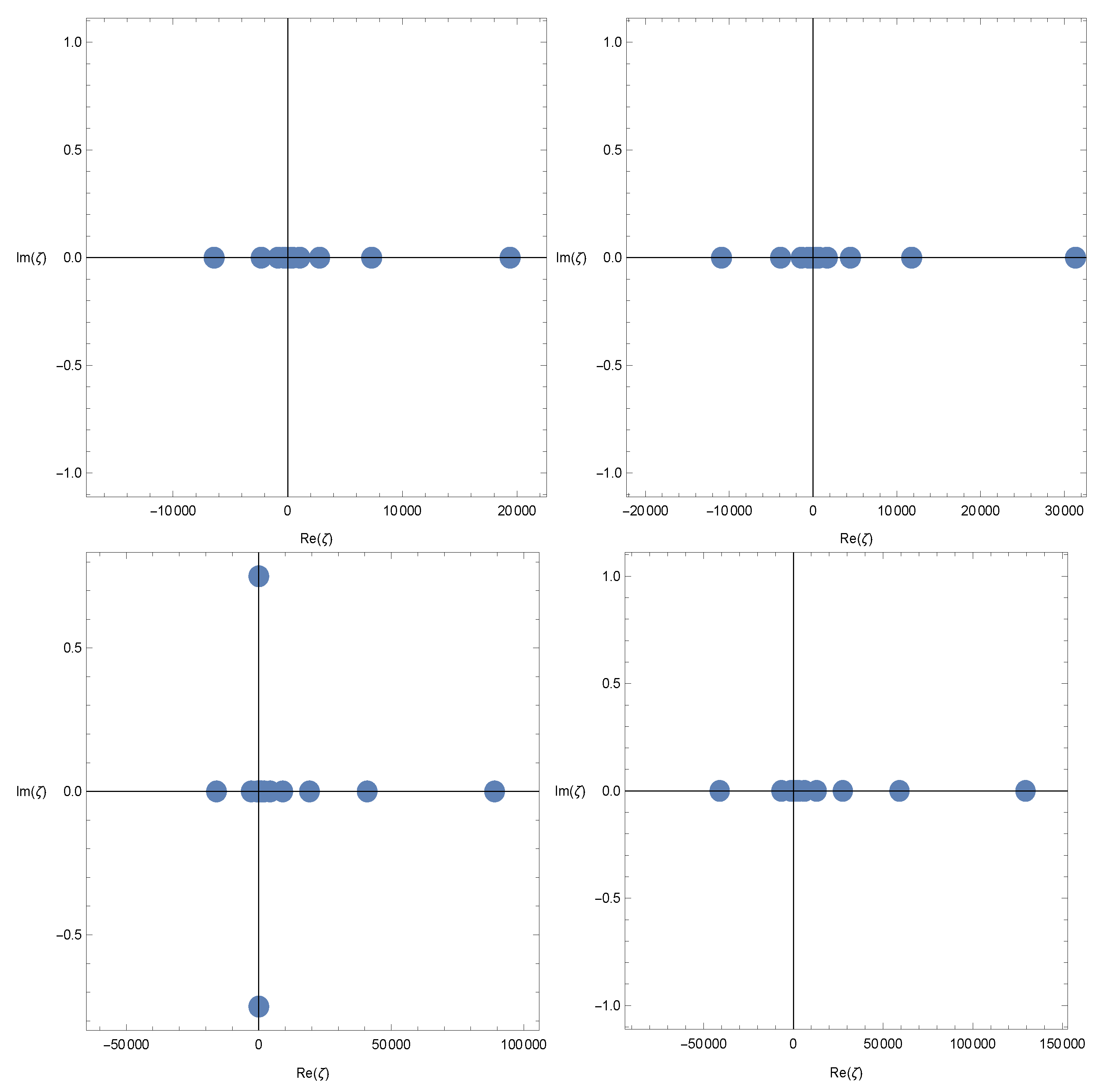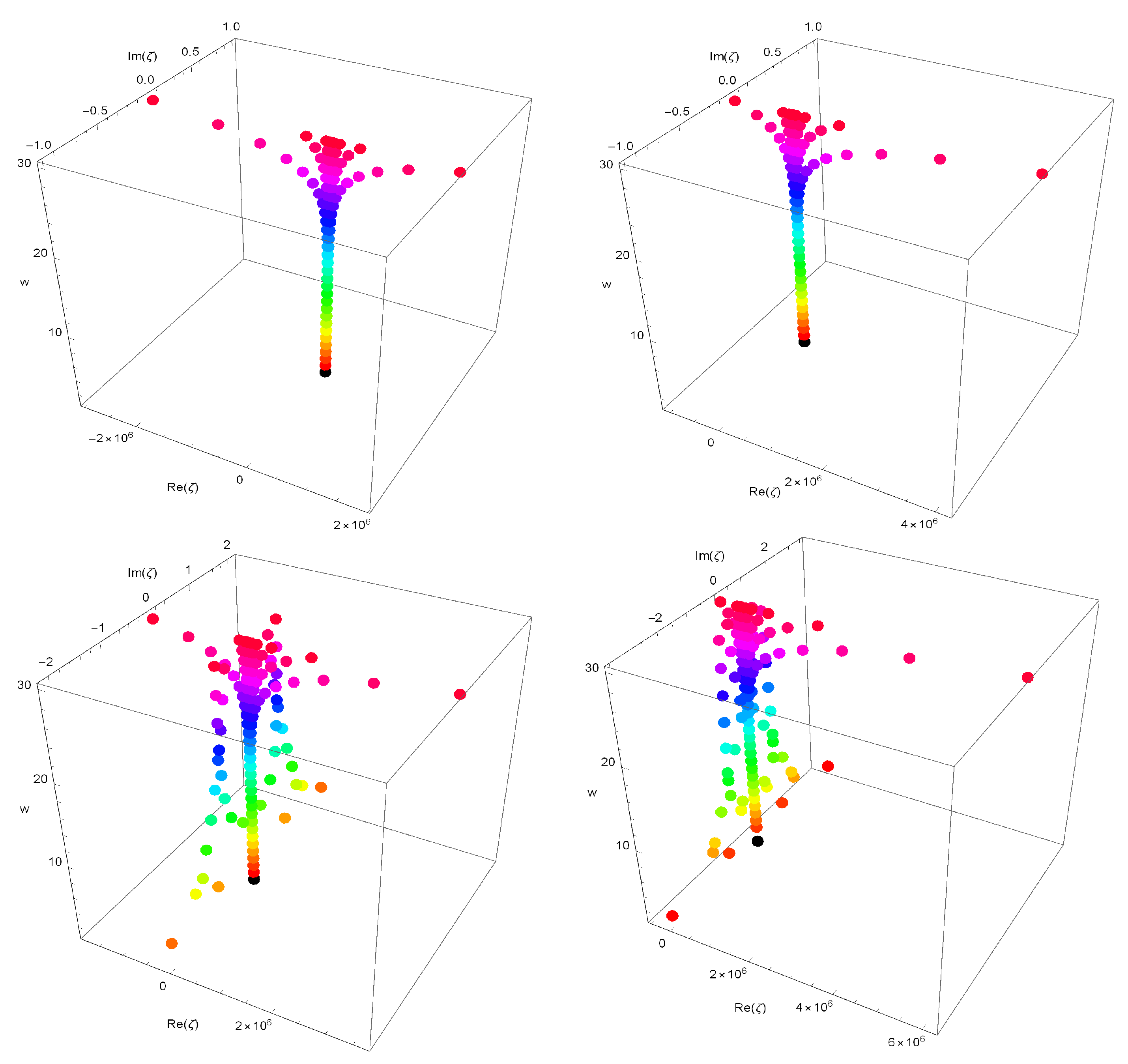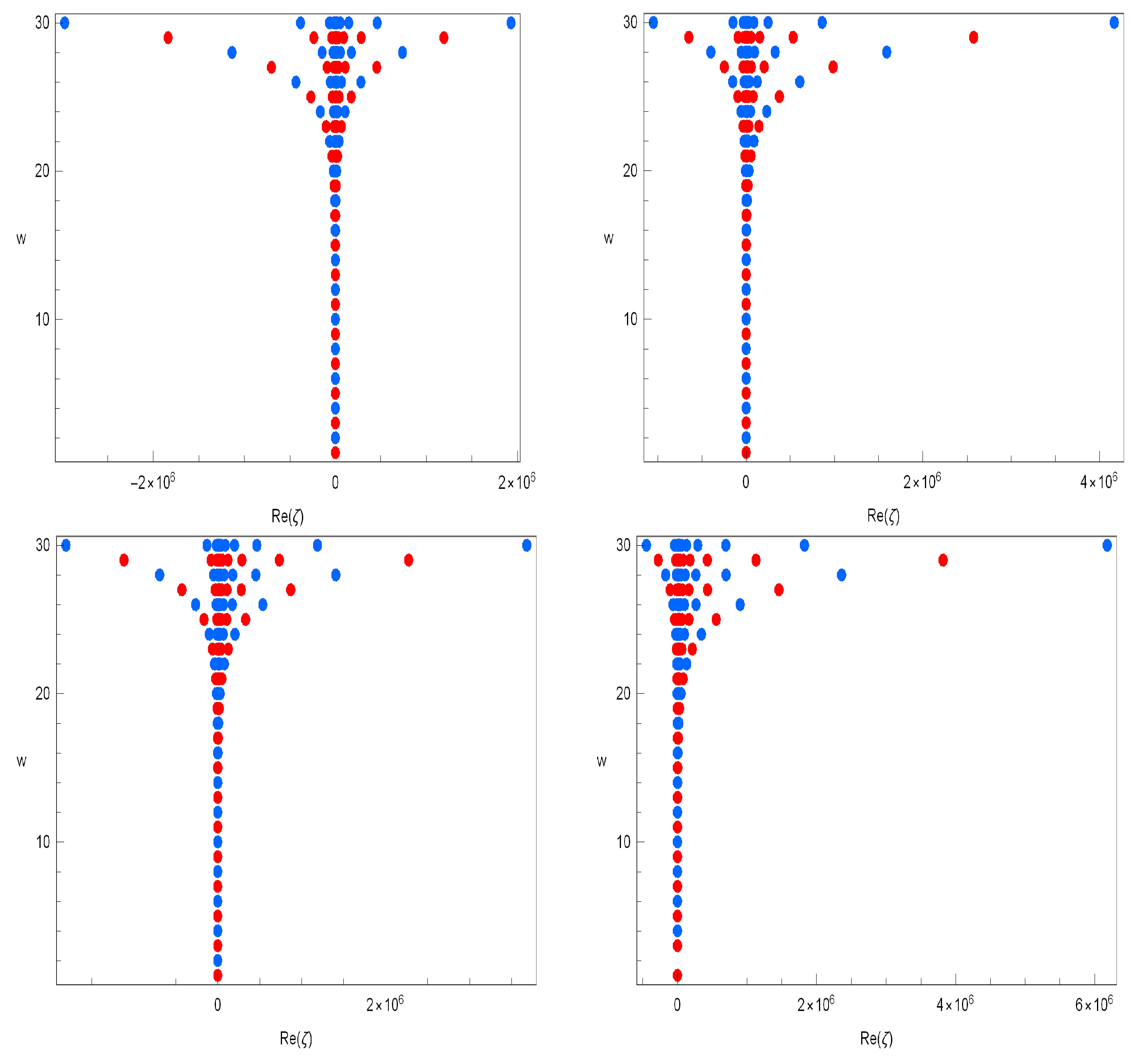1. Introduction
Recently, numerous scholars [
1,
2,
3] have defined and developed methods of generating functions for new families of special polynomials, including Bernoulli, Euler, and Genocchi polynomials. These authors have established the basic properties of these polynomials and have derived a variety of identities using the generating function. Furthermore, by using the partial derivative operator to these generating functions, some derivative formulae and finite combinatorial sums involving the above-mentioned polynomials and numbers have been obtained. These special polynomials also provide the straightforward derivation of various important identities. As a result, numerous experts in number theory and combinatorics have exhaustively studied their properties and obtained a series of interesting results.
For any
,
and
, the Apostol-type Frobenius–Euler polynomials
of order
are introduced (see [
4,
5,
6,
7]).
For
,
are called the Apostol-type Frobenius–Euler numbers of order
. From (
1), we known that
and
where
are the
Apostol–Euler polynomials of order
.
The generalized
-Stirling numbers of the second kind
are given by (see [
8])
for
and
, where
gives the well-known Stirling numbers of the second kind; these are defined as follows (see [
9,
10]).
By referring to (
4), the
-array type polynomials
are defined by (see [
11])
The Apostol-type Bernoulli polynomials
of order
, the Apostol-type Euler polynomials
of order
, and the Apostol-type Genocchi polynomials
of order
are defined by (see [
8,
12]):
and
respectively.
The subject of Golden Calculus (or
F-calculus) emerged in the nineteenth century due to its wide-ranging applications in fields such as mathematics, physics, and engineering. The
-extended finite operator calculus of Rota was studied by A.K. Kwaśniewski [
13]. Krot [
14] defined and studied F-calculus and gave some properties of these calculus types. Pashaev and Nalci [
15] dealt extensively with the Golden Calculus and obtained many properties and used these concepts especially in the field of mathematical physics. The definitions and notation of Golden Calculus (or
F-calculus) are taken from [
15,
16,
17,
18].
The Fibonacci sequence is defined by the following recurrence relation:
where
,
. Fibonacci numbers can be expressed explicitly as
where
and
.
is called Golden ratio. The Golden ratio is a frequently occurring number in many branches of science and mathematics. Pashaev and Nalci [
15] have thoroughly studied the miscellaneous properties of Golden Calculus. Additional references include Pashaev [
18], Krot [
14], and Pashaev and Ozvatan [
19].
The
F-factorial was defined as follows:
where
. The binomial theorem for the
F-analogues (or the Golden binomial theorem) are given by
in terms of the Golden binomial coefficients, referred to as Fibonomials
with
w and
l being non-negative integers,
. The Fibonomial coefficients have following identity:
The
F-derivative is introduced as follows:
respectively. The first and second types of Golden exponential functions are defined as
Briefly, we use the following notations throughout the paper
and
and
satisfy the following identity (see [
17]).
The Apostol-type Bernoulli–Fibonacci polynomials
of order
, the Apostol-type Euler–Fibonacci polynomials
of order
and the Apostol-type Genocchi–Fibonacci polynomials
of order
are defined by (see [
20,
21,
22]):
and
respectively.
In light of the above studies, we define a new family of two-variable polynomials, including the polynomials defined by Equation (
1) with the help of the Golden Calculus. Namely, we introduce the concept of the generalized Apostol-type Frobenius–Euler–Fibonacci polynomials and numbers. Thus, we give some properties of this polynomial family, such as recurrence relations, sums formulae, and derivative relations, by using their generating function and functional equations. Additionally, we establish relationships between Apostol-type Frobenius–Euler–Fibonacci polynomials of order
and various other polynomial sequences, including Apostol-type Bernoulli–Fibonacci polynomials, Euler–Fibonacci polynomials, Genocchi–Fibonacci polynomials, and the Stirling–Fibonacci numbers of the second kind. We also introduce the new family of the generalized Apostol-type Frobenius–Euler–Fibonacci matrix and derive some factorizations of this newly established matrix. Finally, we provide zeroes and graphical illustrations for the generalized Apostol-type Frobenius–Euler–Fibonacci polynomials.
2. Generalized Apostol-Type Frobenius–Euler–Fibonacci Polynomials
In this part, we introduce Apostol-type Frobenius–Euler–Fibonacci polynomials by means of the Golden Calculus. Some relations for these polynomials are also obtained by using various identities. At this point, we begin with the following definition.
Definition 1. Let , , the generalized Apostol-type Frobenius–Euler polynomials of order α are defined by means of the following generating function: When
in (
20),
are called the
Apostol-type Frobenius–Euler–Fibonacci numbers of order
.
Theorem 1. The following summation formulas for the generalized Apostol-type Frobenius–Euler–Fibonacci polynomials of order α holds true:and Proof. By virtue of (
14)–(
16) and (
20), we obtain the desired results. □
Theorem 2. The following recursive formulas for the generalized Apostol-type Frobenius–Euler–Fibonacci polynomials of order α hold true: Proof. Differentiating both sides of (
20) with respect to
and
through Equation (
13), we obtain (
24) and (
25), respectively. □
Theorem 3. The following difference formulas for the generalized Apostol-type Frobenius–Euler–Fibonacci polynomials of order α holds true:and Proof. By virtue of (
20), we can easily proof of Equations (
26) and (
27). We omit the proof. □
Theorem 4. Let , the generalized Apostol-type Frobenius–Euler–Fibonacci polynomials of order α hold true:and Proof. Using generating function (
20), we obtain Equations (
28) and (
29). We omit the proof. □
In the following theorems, we establish some results on the generalized Apostol-type Frobenius–Euler–Fibonacci polynomials of order and some relationships for Apostol-type Frobenius–Euler–Fibonacci polynomials of order related to Apostol-type Bernoulli–Fibonacci polynomials, Apostol-type Euler–Fibonacci polynomials, and Apostol-type Genocchi–Fibonacci polynomials. We now begin with the following theorem.
Theorem 5. For the generalized Apostol-type Frobenius–Euler–Fibonacci polynomials , one has Proof. We set
From the above equation, we see that
through which, in using Equations (
16) and (
20) in both sides, we have
By applying the Cauchy product rule in the aforementioned equation and subsequently comparing the coefficients of
in both sides of the resulting equation, it can be deduced that assertion (
30) holds true. □
Theorem 6. For the generalized Apostol-type Frobenius–Euler–Fibonacci polynomials , one has Proof. Using the following identity
we find that
By applying the Cauchy product rule in the aforementioned equation and subsequently comparing the coefficients of
in both sides of the resulting equation, it can be deduced that assertion (
31) holds true. □
Theorem 7. For the generalized Apostol-type Frobenius–Euler–Fibonacci polynomials of order α, we obtain Proof. Using (
20), we find that
Simplifying the above equation and using Equation (
20), we obtain
By applying the Cauchy product rule in the aforementioned equation and subsequently comparing the coefficients of
in both sides of the resulting equation, it can be deduced that assertion (
32) holds true. □
Theorem 8. The following relation between the generalized Apostol-type Frobenius–Euler–Fibonacci polynomials and Apostol-type Bernoulli–Fibonacci polynomials holds true: Proof. Consider generating function (
20), we have
Using the Cauchy product rule in (
34), the assertion (
33) is obtained. □
Theorem 9. The following relation between the generalized Apostol-type Frobenius–Euler–Fibonacci polynomials and generalized Apostol-type Euler–Fibonacci polynomials holds true: Proof. By virtue of (
20), we have
Using the Cauchy product rule in (
36), the assertion (
35) is obtained. □
Theorem 10. The following relation between the generalized Apostol-type Frobenius–Euler–Fibonacci polynomials and Apostol-type Genocchi–Fibonacci polynomials holds true: Proof. Using (
20), we obtain
Using the Cauchy product rule in (
38), the assertion (
37) is obtained. □
Theorem 11. For the generalized Apostol-type Frobenius–Euler–Fibonacci polynomials of order α, we obtain Proof. From (
20), we obtain
Now, replacing
w with
and equating the coefficients of
leads to Formula (
39). □
Theorem 12. For the generalized Apostol-type Frobenius–Euler–Fibonacci polynomials of order α, we have Proof. Finally, equating the coefficients of the like powers of
, we obtain (
40). □
Theorem 13. Let α and γ be non-negative integers. There is the following relationship between the numbers and the generalized Apostol-type Frobenius–Euler–Fibonacci polynomials of order α, which holds true:andwhere is the Stirling–Fibonacci numbers of the second kind are defined by Proof. By virtue of (
20), we find that
which, on rearranging the summation and then simplifying the resultant equation, yields the relation (
41).
Once more, we examine the following arrangement of generating function (
20) as:
on use of Equations (
44) and (
20). After evaluation, the desired result is obtained (
42). □
Now, we define the new family of generalized Apostol-type Frobenius–Euler–Fibonacci matrices. By using this definition, we obtain the factorizations of this newly established matrix in the following theorems.
Definition 2. Let be the generalized Apostol-type Frobenius–Euler–Fibonacci polynomials. The generalized Apostol-type Frobenius–Euler-Fibonacci matrix, is defined by Theorem 14. For the generalized Apostol-type Frobenius–Euler–Fibonacci matrix , we have Proof. By virtue of (
12), (
16), (
20), and (
45), we find that
□
Theorem 15. For the generalized Apostol-type Frobenius–Euler–Fibonacci matrix , we havewhere is the generalized Pascal matrix [23] via Fibonomial coefficients of the first kind is defined by Proof. Using (
45) and (
12), we obtain
□
3. Some Values with Graphical Representations and Zeros of the Generalized Apostol-Type Frobenius–Euler–Fibonacci Polynomials
In this section, evidence of the zeros of the generalized Apostol-type Frobenius–Euler–Fibonacci polynomials is displayed, along with visually appealing graphical representations. A few of them are presented here:
We investigate the beautiful zeros of the generalized Apostol-type Frobenius–Euler polynomials
of order
by using a computer. We plot the zeros of generalized Apostol-type Frobenius–Euler polynomials
of order
for
(
Figure 1).
In
Figure 1 (top left), we choose
and
. In
Figure 1 (top right), we choose
and
. In
Figure 1 (bottom left), we choose
and
. In
Figure 1 (bottom right), we choose
and
.
Stacks of zeros of the generalized Apostol-type Frobenius–Euler polynomials
of order
for
, forming a 3D structure, are presented (
Figure 2).
In
Figure 2 (top left), we choose
and
. In
Figure 2 (top right), we choose
and
. In
Figure 2 (bottom left), we choose
and
. In
Figure 2 (bottom right), we choose
and
.
Plots of real zeros of the generalized Apostol-type Frobenius–Euler polynomials
of order
for
are presented (
Figure 3).
In
Figure 3 (top left), we choose
and
. In
Figure 3 (top right), we choose
and
. In
Figure 3 (bottom left), we choose
and
. In
Figure 3 (bottom right), we choose
and
.
Next, we calculated an approximate solution satisfying the generalized Apostol-type Frobenius–Euler polynomials
of order
. The results are given in
Table 1. We choose
and
.











